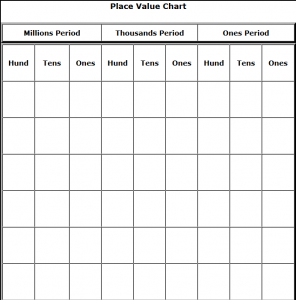Printable Place Value Charts
Place Value Charts - Free printable worksheets with the place values listed and blanks lines below to created and read numbers.
Hundreds
Thousands
Millions
Billions
Decimals
1st - Understand place value.
CCSS.Math.Content.1.NBT.B.2 Understand that the two digits of a two-digit number represent amounts of tens and ones. Understand the following as special cases:
CCSS.Math.Content.1.NBT.B.2a 10 can be thought of as a bundle of ten ones — called a “ten.”
CCSS.Math.Content.1.NBT.B.2b The numbers from 11 to 19 are composed of a ten and one, two, three, four, five, six, seven, eight, or nine ones.
CCSS.Math.Content.1.NBT.B.2c The numbers 10, 20, 30, 40, 50, 60, 70, 80, 90 refer to one, two, three, four, five, six, seven, eight, or nine tens (and 0 ones).
CCSS.Math.Content.1.NBT.B.3 Compare two two-digit numbers based on meanings of the tens and ones digits, recording the results of comparisons with the symbols >, =, and <.
2nd
CCSS.Math.Content.2.NBT.A.1 Understand that the three digits of a three-digit number represent amounts of hundreds, tens, and ones; e.g., 706 equals 7 hundreds, 0 tens, and 6 ones. Understand the following as special cases:
CCSS.Math.Content.2.NBT.A.1a 100 can be thought of as a bundle of ten tens — called a “hundred.”
CCSS.Math.Content.2.NBT.A.1b The numbers 100, 200, 300, 400, 500, 600, 700, 800, 900 refer to one, two, three, four, five, six, seven, eight, or nine hundreds (and 0 tens and 0 ones).
CCSS.Math.Content.2.NBT.A.2 Count within 1000; skip-count by 5s, 10s, and 100s.
CCSS.Math.Content.2.NBT.A.3 Read and write numbers to 1000 using base-ten numerals, number names, and expanded form.
CCSS.Math.Content.2.NBT.A.4 Compare two three-digit numbers based on meanings of the hundreds, tens, and ones digits, using >, =, and < symbols to record the results of comparisons.
4th
CCSS.Math.Content.4.NBT.A.2 Read and write multi-digit whole numbers using base-ten numerals, number names, and expanded form. Compare two multi-digit numbers based on meanings of the digits in each place, using >, =, and < symbols to record the results of comparisons.
5th - Understand the place value system.
CCSS.Math.Content.5.NBT.A.1 Recognize that in a multi-digit number, a digit in one place represents 10 times as much as it represents in the place to its right and 1/10 of what it represents in the place to its left.
CCSS.Math.Content.5.NBT.A.2 Explain patterns in the number of zeros of the product when multiplying a number by powers of 10, and explain patterns in the placement of the decimal point when a decimal is multiplied or divided by a power of 10. Use whole-number exponents to denote powers of 10.
CCSS.Math.Content.5.NBT.A.3 Read, write, and compare decimals to thousandths.
CCSS.Math.Content.5.NBT.A.3a Read and write decimals to thousandths using base-ten numerals, number names, and expanded form, e.g., 347.392 = 3 × 100 + 4 × 10 + 7 × 1 + 3 × (1/10) + 9 × (1/100) + 2 × (1/1000).
CCSS.Math.Content.5.NBT.A.3b Compare two decimals to thousandths based on meanings of the digits in each place, using >, =, and < symbols to record the results of comparisons.
CCSS.Math.Content.5.NBT.A.4 Use place value understanding to round decimals to any place.
